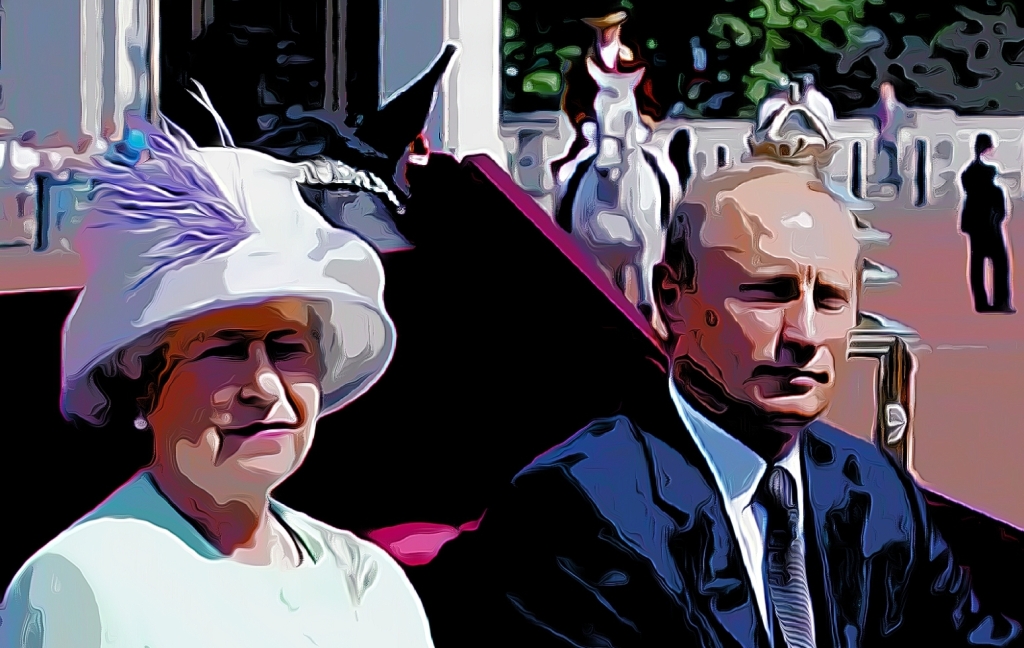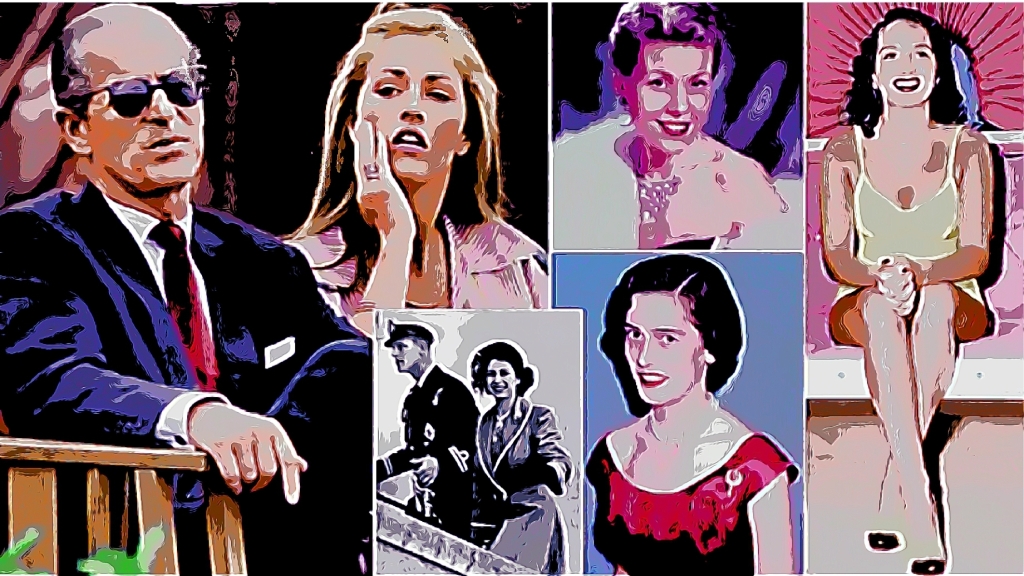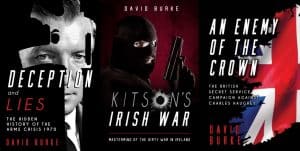Introduction.
The Russian secret service, the FSB, has access to a set of dusty old KGB files. They describe the sexual antics of the British aristocracy, including those of the late Prince Philip, the Duke of Edinburgh.

The information was gathered by Soviet era spies in the London of the late 1950s and early 1960s. In 1972 the Duke gave a hint about his marriage in a speech made to celebrate the couple’s silver wedding anniversary. He described the Queen as having ‘tolerance in abundance’.
It was no secret that the couple slept in separate bedrooms.
If Christine Keeler’s observations are accurate, an Irishman was at the epicentre of the information gathering operation, Stephen Ward. The latter is better known for his pivotal role in the Profumo scandal.

1. Christine Keeler.
Christine Keeler was the woman at the centre of the Profumo scandal. As a teenager, she slept with Captain Eugene Ivanov, a Russian naval attaché at the Soviet Embassy in London, while also having a relationship with the much older John Profumo, the high-flying Conservative MP who was Secretary of State for War. He was a politician tipped to go all the way to 10 Downing Street.

Profumo, who met Keeler in July 1961, dramatically denied a relationship with her in the House of Commons but later admitted he had lied and, in June 1963, resigned in disgrace.
Stephen Ward, the artist and ‘society osteopath’ who had introduced Keeler to Profumo, was subsequently put on trial for living off the immoral earnings of prostitutes. He took an overdose of medication before the jury returned a verdict against him and died shortly thereafter. He was found guilty on two charges.

Keeler asserted that Stephen Ward was in fact a Russian spy and had amassed ‘kompromat’ about Establishment figures for the Soviets. Any information he passed to the Soviets is now available to Vladimir Putin in Moscow.
Lord Louis Mountbatten was a target of huge importance to the Soviets on account of the senior positions he held inside Royal Navy and NATO, not to mention the role he played in India. Stephen Ward knew plenty of people – including Prince Philip – who were acquainted with Mountbatten. With or without an input from Ward, the file on Mountbatten in Moscow must be quite bulky.

2. The pregnant lovers.
In her autobiography, Secrets and Lies (2001), Christine Keeler described how she knew the late Prince Philip had been unfaithful to the Queen:
“But I learned, first hand, from another of the Duke of Edinburgh’s lovers about another child. I was with her when she was pregnant.” [See page 41 of Keeler’s memoirs.]
Kellers claims were studiously ignored by the mainstream media.
Keeler was born in 1942 and came to live in London when she was 15. She had a child who was born prematurely in 1959. During the second half of 1959 she met Stephen Ward and began to socialise in VIP circles. This places her friendship with the pregnant woman she described in her book during the period 1959 onwards.
Prince Philip had married Queen Elizabeth in 1947.

King Charles was born in November 1948.
If Keeler’s account is true, King Charles may have two siblings in their 60s. They would be roughly the same age as Prince Andrew who was born in 1960. They would be slightly older than Prince Edward. A simple DNA test could clarify who they are. The Putin regime already has a map of the Duke’s DNA. The Duke was the great nephew of Empress Alexandra, the wife of Tsar Nicholas. The Romanov family was murdered in 1918. Their bodies were buried in unmarked graves in Russia. The remains were discovered in 1991. The Duke gave the Russians a sample of his DNA in 1993 to help clarify if the remains were those of the Tzarina and her children. It turned out the skeletons were those of the Romanovs.

3. Part of the mission was to collect kompromat on VIPs.
Ward was the son of a vicar who was married to an Irish woman from County Carlow. The Irish connection may account for some of his disdain for the British aristocracy.

It is often commented that Ward procured young women for his VIP ‘friends’ while rarely exploiting them himself. His restraint makes perfect sense, however, if he was a Soviet agent on a mission to collect ‘kompromat’.
Ward had enjoyed plenty of opportunities to observe the Duke. Ward told Keeler how he, Prince Philip and David, the Marquess of Milford Haven, a cousin of Prince Philip:
“had all visited nightclubs together in the 1940s. They were quite wild times and it was all thought to be a little delicate for Prince Philip when Elizabeth became Queen, according to Stephen. He had no time for Philip and would always put him down in conversation for he hated the Establishment. He thought the House of Lords was full of idiots: ‘Through inheritance alone these people have been set up in the House of Lords to make judgements on our account, let me tell you’. He would get more and more heated and red in the face: ‘It’s like a thoroughbred animal; they marry their cousins and land up retarded and deformed with the interbreeding’.” [p. 35.]
4. Philandering Phil.

Prince Philip took many of his secrets to the grave. His will has been locked away in a safe controlled by the Family Division of Britain’s High Court. The justification for this was to preserve the ‘dignity’ of Queen Elizabeth. Put simply, the late monarch’s blushes are being spared because her wayward husband undoubtedly made provision for one or more of his former lovers and also, possibly, his extra marital offspring. The application to bury the will was made by Britain’s attorney-general at tax-payers’ expence.

The Duke was played by Jonathan Pryce in seasons 5 and 6 of the Crown. While Netflix provided a tame semi-fictionalised depiction of some of his antics, the dusty files in the KGB’s vaults undoubtedly contain far more damaging material.
If Putin decides to leak the content of the files which relate to the Duke, King Charles III may acquire clarity as to whether or not he has one or more half siblings. In the era of sophisticated DNA testing, it would be possible to test the veracity of such claims.


5. Ward’s access to the Royal Family.
Ward was also a portrait artist, a talent that allowed him gain access to the most senior members of the Royal Family.

After the Profumo scandal erupted, 123 of his portraits, including members of the Royal Family such as Prince Philip and the Queen’s sister, Princess Margaret, were purchased from an exhibition at the time of the scandal for £11,517, a fortune in those days.
The purchase was made by a man who refused to give his name and paid for them by way of a bank draft.

6. The Wimpole Mews Spy Ring.
In her autobiography, Christine Keeler also asserted that Sir Roger Hollis was a Soviet mole and a part of a network consisting of Stephen Ward and Sir Anthony Blunt. Hollis served as the Director-General of MI5, 1956 – 1965. Blunt was a KGB mole who penetrated MI5 during WW2. Keeler made the claim in her book, Secrets and Lies (2001). These claims were also ignored by the mainstream media.

There has been much debate about the loyalty of Hollis. Many books address the issue. Peter Wright wrote about it in his bestselling book ‘Spycatcher’ and generated a massive controversy. Keeler’s revelations should have received similar wdespread coverage but didn’t. Every other facet of her life has led to media headlines. This issue was simply too hot for the media barons who own the British press and they covered it up. Many of them have been awarded with honours by the British Government and Buckingham Palace since.

7. Keeler knew about the treachery of the Director-General of MI5 decades before the public became aware there was any doubt about his loyalty.
Keeler lived at Ward’s residence at Wimple Mews for a while. She was witness to a string of meetings between D-G Hollis and Ward at the address.
She could not have known that D-G Hollis was a Soviet mole – or even suspected of having been one – until the 1980s when the allegations about Hollis entered the public domain, except from her observation of him at Wimple Mews.
Keeler says she told Lord Denning about D-G Hollis in 1963 while the latter was carrying out his controversial inquiry into the Profumo affair and that he took notes of what she said. Hence, there is one straightforward way to help resolve the question of D-G Hollis’ loyalty: declassify Denning’s files.

8. Ward’s cover story
There have been allegations that Ward was asked by MI5 to spy on Captain Eugene Ivanov. Insofar as D-G Hollis was concerned, this has the appearance of a ruse designed to distract potential suspicious MI5 insiders from finding out what was really afoot. Hence, if anyone discovered that Ward was meeting with Hollis, he or she could have been told that Ward was an agent of MI5 and there was nothing about which to be worried.
9. The successful theft of Britain’s military secrets by Ward and Ivanov.
Ivanov survived the Cold War. After the collapse of the Soviet Union, he revealed that he had used Ward’s social network to gain access to Profumo’s home where he took photograph of some of Profumo’s secret documents.
Acting in parallel to this, Ward encouraged Keeler to procure secrets from Profumo.
10. The toilet creeping traitor at Buckingham Palace
Despite enough circumstantial evidence to fill the pages of various official reports and books by espionage historians, D-G Hollis was never arrested.

His colleague Sir Anthony Blunt, a cousin of the Queen Mother, was not so lucky. Blunt joined MI5 at the start of WW2 and supplied the Soviets with classified and sensitive secrets throughout the conflict.
Blunt was a friend of the Royal Family, especially Mountbatten with whom he socialised in Ireland. Blunt liked to ‘cottage’, that is to say he frequented public toilets where it was possible to pick up young males for seedy sexual encounters. He knew the secrets of many VIPs who engaged in similar practices.

The perceived wisdom is that a remorseful Blunt cut all links with Moscow after he retired from MI5 after the war ended and became the Surveyor of the King’s Pictures at Buckingham Palace. Keeler’s revelations, however, indicate that he was still an active Soviet agent as late as the early 1960s. Blunt eventually confessed his role as a Soviet agent and hence there is no doubt about his duplicity, merely how long it lasted.
Blunt may have supplied Moscow with an abundance of information about the escapades of the Royals and their side kicks. Worse still, he may have kept them informed about the crimes being committed by the extensive network of VIP paedophiles with whom he associated in Britain and Ireland for decades. They included Mountbatten, Lord Ross of Birr Castle and others.
11. The depth of the KGB’s penetration of MI5 and MI6 may be unfathomable. Hence, the ‘kompromat’ they passed to Moscow about British VIPs must be voluminous
If D-G Hollis was the traitor Keeler says he was, he had over a decade as D-G to help fellow conspirators climb the MI5 ladder. During all that time MI5 was in receipt of mountains of embarrassing information about British VIPs. According to Keeler, NATO secrets were also sought by Hollis and Ward. John Profumo, as Minister for War, was an obviously high value target as he knew NATO plans, including the deployment of missiles in Europe.
Mountbatten was a senior NATO naval commander and therefore another GRU and KGB target of high value.
The British media has been obsessed with the hunt for the so-called ‘Fifth Man’ inside the Cambridge Spy Ring for decades. The Cambridge Ring consisted of Kim Philby, Guy Burgess, Blunt and Donald Maclean. British commentators now generally agree that a man called John Cairncross was the Fifth Man. Yet, there is no logical reason to believe there were only five high level traitors inside the Establishment or that Cambridge was the only campus visited by Soviet talent scouts. Hollis was educated at Oxford.

If Keeler’s revelations about D-G Hollis are reliable, there is a strong possibility that MI5 was nothing less than a harbour for traitors. A slew of books have been published which make out cases against a variety of suspected traitors including the man D-G Hollis appointed as his deputy, Graham Mitchell. Another senior MI5 officer, Guy Liddell, was also put under the microscope as was Lord Victor Rothschild who served in MI5 during WW2.
12. And then there is Mountbatten.
Another lever for Putin to pull relates to Lord Louis Mountbatten, the former NATO Commander Allied Forces Mediterranean. The FBI spied on him as they were afraid he might have been compromised by the Soviets because of his sex life. Declassified FBI files reveal the Americans discovered Mountbatten had a ‘perversion for young boys’. One shudders to think what the KGB files contain about his sexual habits.
A detailed account of Mountbatten’s paedophilia can be accessed here: Mountbatten dossier; royalty, child abuse and a murder: Survivors make accusations. A boy committed suicide. A child killer escaped justice. MI5, MI6 and the RUC were involved. By David Burke..


David Burke is the author of ‘Deception & Lies, the Hidden History of the Arms Crisis 1970’ and ‘Kitson’s Irish War, Mastermind of the Dirty War in Ireland’ which examines the role of counter-insurgency dirty tricks in Northern Ireland in the early 1970s. His new book, ‘An Enemy of the Crown, the British Secret Service Campaign against Charles Haughey’, was published on 30 September 2022. These books can be purchased here:
https://www.mercierpress.ie/irish-books/kitson-s-irish-war/
https://www.mercierpress.ie/irish-books/an-enemy-of-the-crown/

